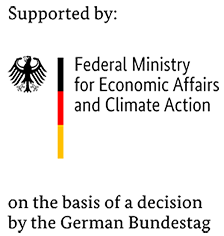energy data-X:
The innovative data ecosystem for the energy industry
1. The initial situation in the electricity grid: the transmission grid must become more flexible – and more digital
Germany and Europe have set themselves clear climate targets: Germany wants to be CO2-neutral by 2045, the EU by 2050. In order to achieve these goals, we must consistently decarbonise. This includes, in particular, meeting our energy needs from renewable energy sources instead of fossil fuels. Germany wants to phase out coal-fired power generation by 2038 at the latest.
However, the transition will have consequences for the transmission grid: it will have to overcome new challenges associated with the increasing generation of energy from wind and electricity. This primarily includes: weather-related fluctuations in electricity production, existing bottlenecks in the transmission of electricity generated from renewable sources from north to south and west and ensuring grid stability by balancing feed-in and feed-out.
A key response is the digitalisation of the grid and the intelligent use of digital data to control the electricity system of the future. This also includes future system security and affordability of the energy supply.
2. The initial situation in the data network:
Europe is creating the next generation of data infrastructure
Data exchange between organizations in Europe is currently limited by different proprietary and not consistently interoperable technologies that do not have the required level of trust between partners already implemented in the design. The EU is responding to this by creating its own secure data ecosystem (Data Space) in Gaia-X. This next generation of European data infrastructure is aimed at all companies and organizations that want to exchange their diverse data or create added value from it and develop new data-driven business models. The aim is to create added value through the use of data and strengthen the European single market.
2. The initial situation in the data network:
Europe is creating the next generation of data infrastructure
Data exchange between organizations in Europe is currently limited by different proprietary and not consistently interoperable technologies that do not have the required level of trust between partners already implemented in the design. The EU is responding to this by creating its own secure data ecosystem (Data Space) in Gaia-X. This next generation of European data infrastructure is aimed at all companies and organizations that want to exchange their diverse data or create added value from it and develop new data-driven business models. The aim is to create added value through the use of data and strengthen the European single market.
For the associated data transfers, Gaia-X provides a set of rules based on European values (e.g. data protection). Gaia-X thus enables and promotes the creation of data ecosystems that comply with common rules and, based on an identity and trust procedure, ensure that the players involved in the data ecosystem are known and trustworthy. The key principles include: federated (decentralized) structure of the data ecosystem, sovereignty of data exchange, security and trust with regard to participants, data security, data protection, interoperability and scalability.
The first services and data ecosystems, e.g. Catena-X in the automotive industry, have been available in Germany since the beginning of 2022. Numerous other funding projects such as Manufacturing-X for the use of data throughout the entire production and supply chain are in the starting blocks.
3.The answer:
“energy data-X” – the modern data ecosystem for the energy industry
The developments in the electricity grid and the data network described above are now coming together: With “energy data-X”, the first data ecosystem for the energy industry is being tested and built. The project, which is funded by the Federal Ministry for Economic Affairs and Climate Protection, will run for three years. It is being carried out by a consortium around TenneT, with a total of 14 partners from the energy industry, ICT, science and standardization participating.
The aim of the project is to create a data ecosystem in which all players in the energy industry can participate and benefit from. The basis for this is an efficient and secure exchange of data, in particular the improved integration of renewable energy systems, as well as the facilitation of data-driven innovative business models. The technological basis is the European Gaia X standard (open source etc.). In addition, a key aspect of digitalization in the energy industry is being completely rethought: the innovative data ecosystem can reduce the costs of implementing the energy transition. Taken together, the project makes an important contribution to achieving the German and European energy and climate protection targets.
Once the project has been completed, the new energy data-X data ecosystem will be rolled out to the wider market. However, a key political course still needs to be set for this and further monitoring and support from the regulatory authorities and the BMWK will be required.
4. The bigger vision:
Networking with other data ecosystems
energy data-X is just the beginning for the energy sector. Similar data ecosystems based on Gaia-X are emerging in other areas. They all have one thing in common: they rely on large amounts of data (big data) and the intelligent, sovereign use of this data. A key element in the future will be intersectoral data exchange, i.e. networking with other data ecosystems in Gaia-X, such as energy data-X with Catena-X (automotive industry) or Manufacturing-X (production and supply chains). One application scenario, for example, is the use of vehicle sensor data for feed-in forecasts by transmission system operators.
5. Our values:
A strong consortium with a focus on innovation
The development of a new, previously non-existent data ecosystem is both a challenge and an incentive. 14 strong partners are therefore involved in the energy data-X consortium and contribute their respective strengths and expertise – above all TenneT as consortium leader. All partners contribute to the success of the project with their comprehensive technological expertise, high motivation, ability to innovate and collaborative partnership.


